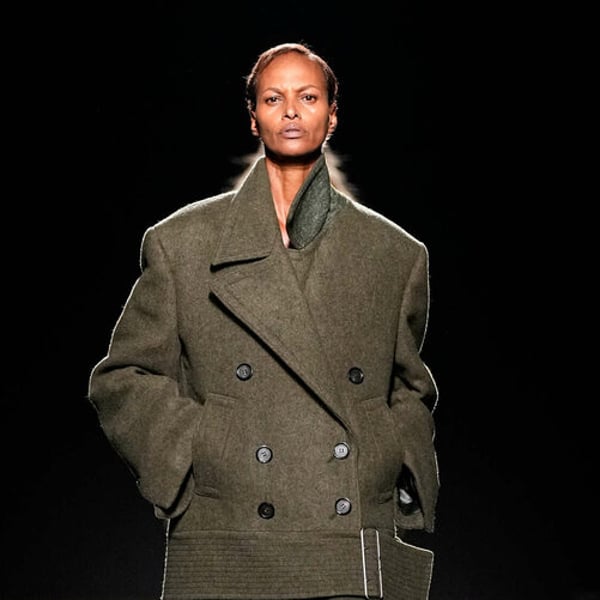Translated by
Nicola Mira
Published
Feb 27, 2024
Milan Fashion Week designers are still willing to believe in freezing winters. Some labels even had snow falling during their presentations, like Emporio Armani and Jacob Cohen. The women’s ready-to-wear collections for the Fall/Winter 2024-25 unveiled on the Milanese runways on Saturday did feature an array of snug, enveloping clothes, like oversize coats and capes, and especially wool and knitwear galore, as seen at Ferragamo, Jil Sander, Missoni and Bally.
Maximilian Davis has designed an elegant, sophisticated collection for Ferragamo. He has continued his work on a quiet luxury concept, creating a winter wardrobe consisting of highly contemporary, down-to-earth essentials, adopting refined materials and a stunning colour palette.
The silhouettes were strictly monochrome, the items in each look, ties and handbags included, made in tone-on-tone fabrics. The colours ranged from khaki to brown, maroon and black, plus a variety of reds and ochre yellow. The shades were often glossy, thanks to the ways some fabrics were treated, like dresses in lacquered organza and metallic-finished satin, and others made of scale-like sequins. Other looks were in lavish, shimmering leather that seemed to capture the light.
Jackets, tops, skirts, dresses coats and capes came in soft leather and thick wool, as well as cashmere and felt. The outfits’ pared-down lines gave an impression of comfort and solidity. A martingale at the back of a coat turned into a thick belt fastening jacket and skirt, and in some cases into a wide diagonal band layered over a dress’ top and sleeves.
A utilitarian vibe, embodied in the superb wader boots, the four-pocket jackets, and the military-style shorts and coats, contrasted with a more glamorous, festive register reminiscent of the Roaring Twenties, evident in the long swinging tassels morphing into a skirt, or in the wave-like embroidery on some dresses, and in the sheer, lightweight outfits and knitted sets that softly embraced the body.

The atmosphere was plush and experimental at Jil Sander, with cobalt blue sculptures of gramophone horns at the centre of a stage covered in sage green carpeting, down which the models strolled to a live soundtrack played by US musician-producer Mk.gee. The tone was set for a highly sensorial collection, whose garments contoured the body’s soft curves.
Rounded shoulders and sleeves, barely marked waists and garments flaring at the hips gave an ovoid feel to the collection, enveloping the body in cocooning clothes. Designers Lucie and Luke Meier played with volumes, 3D effects and soft, warm fabrics, using delicate deer leather, the fur of long-haired Himalayan goats, colourful short furs, silk tassels and wool.
Ample throw-like scarves were layered over generously proportioned coats. Swathes of cosy fabrics dropping down to the calves and climbing back up the shoulders were fashioned into elegant double-thickness capes. Quilted fabrics, normally used to line coats, turned into jackets, overcoats, tunics and even elegant evening dresses, while ultra-puffy long down parkas looked like giant life jackets.
Missoni has gone back to its roots. Creative Director Filippo Grazioli assembled a wardrobe based on a single motif, stripes. In 1958, stripes featured in the Italian label’s first collection, predating even Missoni’s legendary zigzag chevron pattern. Next winter, stripes will be everywhere at Missoni. Chasing after each other, intermingling, colliding and exploding in an array of different shades.
Stripes will be straight and vertical, thin or thick, sometimes going off on a diagonal tangent, or turning horizontal. Missoni has created optical black-and-white striped effects in trousers, jackets and longline overcoats, and on maxi dresses draped around the body and open on the side. Feet and legs were encased in skintight boots-leggings in the same striped patterns, and some models wore matching striped turbans tied at the back of the head, with long ribbons dropping down their backs.
Grazioli said “I wanted to have fun, re-introducing this stripe motif and turning it into something completely new and different, in new colours and combinations, making it small and large, volumising it and featuring it in plenty of knitwear, draped around the body like ultra-soft armour.” Grazioli worked with wool and knitwear in all sorts of ways, cutting, stitching and weaving the fabrics in shearling effects to make jackets and dresses. Elsewhere, wool thread was knitted to become almost furry, and was used to make ballooning tops looking like huge balls of wool.
In his second collection for Bally, Simone Bellotti stepped into bolder territory, adding a subversive touch to the label’s signature Swiss rigour. In his collection notes, Bellotti said he was inspired by mystical legends of mountain folklore. The result was an intriguing wardrobe, in which even the simplest garments twinkled with a slightly rebellious touch.
The show opened with a series of loden coats, dresses and jackets, impeccably cut but with unusual proportions, the lines flaring at the back and on the sides, cape-fashion. For example, the skirts came down over the knee at the front, but were cut shorter at the back. Or they wrapped tightly around the legs and sides, with a high waist and slits at the front and back.
Bally’s women’s looks featured dresses and prim navy-blue suits worn over basic sky-blue blouses. But irreverent details cropped up in these austere outfits, like lace-up thigh-high boots, and plenty of leather, from classic black jackets to a baby-blue shirt-dress knotted at the front. Not to mention studded garments, like a dress riddled with pins and metal balls, and a gilet covered in mini metal bells.
The show was also the opportunity for Bally, a luxury footwear label owned by JAB Holding Company, to release the first issue of its magazine, a charming samizdat-like project featuring previously unseen work by Swiss artist Beni Bischof.
Copyright © 2024 FashionNetwork.com All rights reserved.









